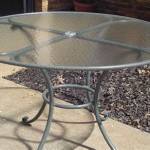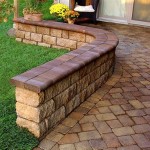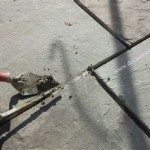DIY Patio Paver Cutting Without A Sawzall: A Comprehensive Guide
Creating a stunning patio often involves intricate designs and custom fits, requiring homeowners to cut pavers to specific shapes and sizes. While a sawzall (reciprocating saw) is a viable option, it is not always the most precise or readily available tool for this task. This article explores alternative methods for cutting patio pavers without relying on a sawzall, focusing on techniques that emphasize accuracy, safety, and accessibility for the DIY enthusiast.
The absence of specialized power tools should not deter individuals from undertaking patio projects. Several effective manual and alternative powered methods exist for achieving clean and precise paver cuts. These methods, when properly executed, can deliver results comparable to those achieved with more expensive equipment. The key to success lies in understanding the properties of the pavers, selecting the appropriate tools and techniques, and prioritizing safety throughout the cutting process.
Scoring and Chiseling Pavers
One of the most common and accessible methods for cutting pavers without a sawzall involves scoring and chiseling. This technique utilizes a scoring tool and a brick chisel, along with a hammer or mallet, to create a controlled break along a designated line. The success of this method hinges on creating a deep and consistent score line on the paver's surface.
The first step is to accurately measure and mark the desired cut line on the paver. A straight edge, such as a metal ruler or a level, is crucial for ensuring a straight and accurate score. A masonry pencil or marker can be used to create a clear and visible line. Once the line is marked, the scoring tool, which is typically a specialized masonry tool with a hardened steel wheel, is used to repeatedly trace the line. Multiple passes with firm pressure are required to create a score line that is deep enough to guide the break.
The depth of the score line is critical. If the score is too shallow, the paver is likely to crack unevenly or shatter during the chiseling process. The ideal depth should be approximately 1/8 to 1/4 inch, depending on the thickness and composition of the paver. After scoring, the paver is placed on a solid surface, preferably with the score line positioned directly over a sand bed or a narrow gap. This provides support on either side of the cut line and minimizes the risk of the paver shattering indiscriminately.
The brick chisel is then positioned along the score line. A hammer or mallet is used to strike the chisel firmly and repeatedly. It is important to work along the entire length of the score line, applying even pressure to encourage a clean and controlled break. Avoid applying excessive force in any one spot, as this can lead to chipping or unevenness. With each strike of the chisel, the paver should begin to crack along the score line. Continue the process until the paver separates completely.
After the paver is separated, the cut edges may require some refining. A brick hammer or a rubbing stone can be used to smooth any rough edges or protruding pieces. This step is important for achieving a professional-looking finish and ensuring that the pavers fit snugly together.
Utilizing a Paver Splitter
For larger paver cutting projects or when a higher degree of precision is required, a paver splitter is a valuable tool. A paver splitter, also known as a block splitter, is a manual or hydraulic machine designed specifically for cutting pavers and concrete blocks. These devices utilize a blade or a set of blades to apply even pressure to the paver, resulting in a clean and straight cut.
Manual paver splitters are typically operated by a lever or a handle that the user pulls or pumps to generate the force required for cutting. Hydraulic paver splitters, on the other hand, use a hydraulic pump to generate the necessary pressure. Hydraulic models generally require less physical effort but also tend to be more expensive.
To use a paver splitter, the paver is first placed on the machine's bed, ensuring that the desired cut line is aligned with the blade. Accuracy is essential at this stage, as even a slight misalignment can result in an inaccurate cut. Many paver splitters are equipped with adjustable guides or fences to assist in ensuring proper alignment.
Once the paver is properly positioned, the lever or handle is operated to lower the blade onto the paver. The blade applies pressure gradually, causing the paver to crack and split along the predetermined line. It is important to apply steady and even pressure to achieve a clean and controlled break. Avoid jerking or forcing the blade, as this can damage the paver or the splitter.
Paver splitters are particularly effective for cutting pavers of uniform thickness and composition. However, they may not be suitable for cutting pavers with irregular shapes or those that are excessively hard. Also, certain aggregates present in some pavers may present cutting challenges, even to a paver splitter. It is important to select a paver splitter that is appropriate for the type and size of pavers being used.
Safety is paramount when operating a paver splitter. Always wear safety glasses to protect the eyes from flying debris. Additionally, it is important to keep hands and fingers clear of the blade during operation. Follow the manufacturer's instructions carefully and never attempt to modify or repair the splitter without proper training and expertise.
Alternative Power Tool Options: Angle Grinder with Diamond Blade
While the focus is on avoiding a sawzall, an angle grinder equipped with a diamond blade presents a viable alternative for cutting pavers. This method offers more control and precision compared to scoring and chiseling, and it is often faster than using a manual paver splitter. However, it requires greater caution and protective measures due to the potential for dust and flying debris.
An angle grinder is a handheld power tool that uses a rotating abrasive disc to grind, cut, and polish materials. When fitted with a diamond blade specifically designed for cutting concrete and masonry, it becomes an effective tool for cutting pavers. Diamond blades are significantly harder and more durable than traditional abrasive discs, allowing them to cut through the tough materials used in paver construction.
Before using an angle grinder, it is essential to wear appropriate safety gear. This includes safety glasses, a dust mask, hearing protection, and work gloves. Cutting concrete and masonry generates a significant amount of dust, which can be harmful to the respiratory system and the eyes. Proper ventilation is also important, and it is advisable to work outdoors or in a well-ventilated area.
To cut a paver with an angle grinder, first mark the desired cut line accurately. Secure the paver in place using clamps or a vise to prevent it from moving during the cutting process. A steady hand is crucial for achieving a straight and accurate cut. Begin by making a shallow cut along the marked line, gradually increasing the depth with each pass. Avoid applying excessive pressure, as this can overheat the blade and damage the grinder.
One advantage of using an angle grinder is the ability to make curved or irregular cuts. This is particularly useful for creating custom patio designs or fitting pavers around obstacles. However, making curved cuts requires greater skill and control, and it is important to practice on scrap pavers before attempting to cut the final pieces.
After cutting, the edges of the paver may be rough and uneven. A rubbing stone or a brick hammer can be used to smooth the edges and remove any protruding pieces. It is also important to clean the paver thoroughly to remove any dust or debris.
When using an angle grinder, it is crucial to follow all safety precautions outlined by the manufacturer. Never operate the grinder without the guard in place, and always use the correct type of blade for the material being cut. Regularly inspect the blade for wear and damage, and replace it as needed. Additionally, it is important to unplug the grinder before changing blades or performing any maintenance.
Each of these methods offers a viable alternative to using a sawzall for cutting patio pavers, allowing homeowners to undertake DIY projects with readily available tools and techniques. By understanding the principles behind each method and prioritizing safety, individuals can achieve professional-looking results without the need for specialized equipment.

6 Ways To Cut A Paving Stone Western Interlock

6 Ways To Cut A Paving Stone

6 Ways To Cut A Paving Stone

How To Cut Pavers Easy And Dust Free

How To Repair A Paver Patio Maintenance Faithfully Free

6 Ways To Cut A Paving Stone

How To Repair A Paver Patio Maintenance Faithfully Free

How To Build A Flagstone Patio Helpful Guide Backyard Water Garden

6 Ways To Cut A Paving Stone Western Interlock

6 Ways To Cut A Paving Stone Western Interlock
Related Posts








